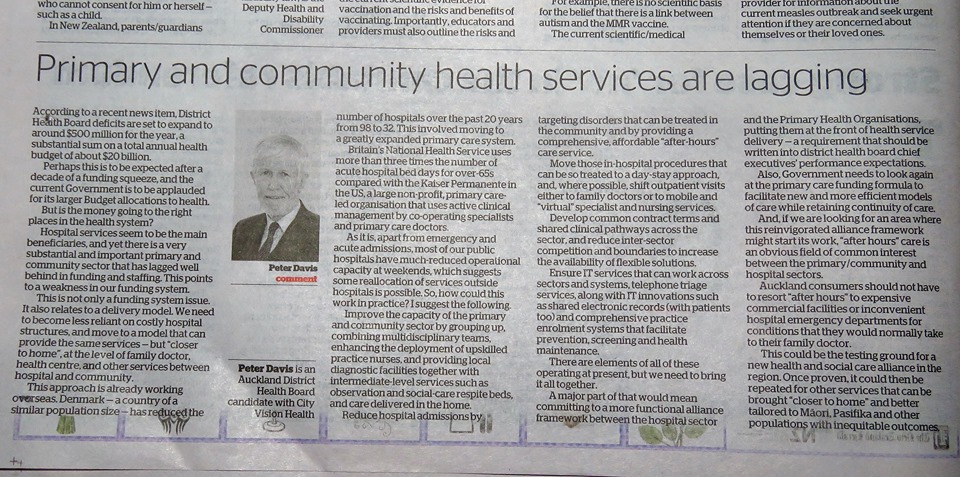City Vision Heath candidate, Peter Davis wrote an excellent OpEd in the NZHerald which is copied below for your reading pleasure.
Health and Social Care – “Closer to Home”
According to a recent news item, District Health Board (DHB) deficits are set to expand to around $500 million for the year, a substantial sum on a total annual health budget of about $20 billion. Perhaps this is to be expected after a decade of a funding squeeze, and the current government is to be applauded for its larger Budget allocations to health. But is the money going to the right places in the health system?
Hospital services seem to be the main beneficiaries, and yet there is a very substantial and important primary and community sector that has lagged well behind in funding and staffing. This points to a weakness in our funding system which the DHB model seems unable to overcome – the neglect of primary and community services.
This is not only an issue about the funding system. It also relates to a delivery model. We need to become less reliant on costly hospital structures, and move to a model that can provide the same services – but “closer to home”, at the level of family doctor, health centre, and other services that are intermediate between hospital and community.
This approach is already working overseas. For example, Denmark – a country of a similar population size – has reduced the number of hospitals over the last 20 years from 98 to 32. This involved moving to a greatly-expanded primary care system. Another example: the United Kingdom’s NHS uses over 3 times the number of acute hospital bed days for over 65s compared to the Kaiser Permanente in the US, a large non-profit, primary care-led organization that uses active clinical management by cooperating specialists and primary care doctors.
As it is, apart from emergency and acute admissions, most of our public hospitals have greatly reduced operational capacity at weekends, which suggests that some reallocation of services outside hospital walls is possible. So, how could this work in practice? I suggest that we can:
- Improve the capacity of the primary and community sector by grouping up, combining multidisciplinary teams, enhancing the deployment of upskilled practice nurses, and providing local diagnostic facilities together with intermediate-level services such as observation and social care respite beds, and care delivered in the home.
- Reduce hospital admissions by targeting disorders that can be treated in the community and by providing a comprehensive, affordable “after-hours” care service.
- Move those in-hospital procedures that can be so treated to a day-stay approach, and, where possible, shift outpatient visits either to family doctors or to mobile and “virtual” specialist and nursing services.
- Develop common contract terms and shared clinical pathways across the sector, and reduce inter-sector competition and boundaries to increase the availability of flexible solutions.
- Ensure IT services that can work across sectors and systems, telephone triage services, along with IT innovations such as shared electronic records (with patients too), and comprehensive practice enrolment systems that facilitate prevention, screening, and health maintenance.
There are elements of all of these operating at present, but we need to bring it all together. A major part of that would mean committing to a more functional alliance framework between the hospital sector and Auckland the Primary Health Organisations, putting them at the front of health service delivery – a requirement that should be written into DHB CEOs’ performance expectations.
Also, Central government needs to look again at the primary care funding formula in order to facilitate new and more efficient models of care while retaining continuity of care. And if we are looking for an area where this reinvigorated alliance framework might start its work, “after hours” care is an obvious field of common interest between the primary/community and hospital sectors. Auckland consumers should not have to resort “after hours” to expensive commercial facilities or inconvenient hospital Emergency Departments for conditions that they would normally take to their family doctor.
This could be the testing ground for a new health and social care alliance in the region. Once proven, it could then be repeated for other services that can be brought “closer to home” and better tailored to Maori, Pasifika and other populations with inequitable outcomes.


Hi Peter , I really like your vision for connected community care with less reliance on hospital stays . As Auckland already has excellent health care which will be even better with your ideas, could you and Helen please move to Whangarei and sort out our medical mess out . I have to wait 6 weeks for a GP appointment .
Thank you very much for your comment Leonie.
Yes, primary care/general practice has been neglected, and that is particularly acute outside the main centres. While there is no “magic bullet”, I would say that we need a combination of an adjustment to payments to GP practices to recognise the difficulties of recruitment and the needs of practice populations in areas that are hard to staff, plus expanded skills and potential of non-medical personnel like practice nurses so that they can take on more of the non-diagnostic work.
Peter